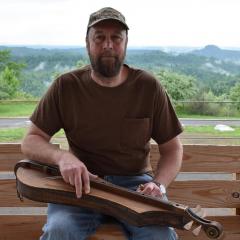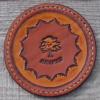-
Posts
88 -
Joined
-
Last visited
Content Type
Profiles
Forums
Events
Blogs
Gallery
Posts posted by highnoonhunter
-
-
Two more natural dyes I have used are Goldenseal (locally known as yellow root) and Red Puccoon root (locally known as blood root).
Noted: I have yet to use these on leather, but I have used them on cloth, feathers, and wood.
I simply bring the roots to a gentle boil for about 10 minutes, and then let them set until cool. I store them in a mason jar. The Goldenseal makes for a rich to bright yellow, and the Red Puccoon can be blood red to orange (depending on the color of the item you are dying). And you can mix them to get colors in between.
The coverage is good if you don't over water. I usually just cover the roots with water.
I experimented with soaking them in rubbing alchohol once, and it worked, but the colors weren't as dark.
Also, the will mold in the jar over time. My main use was in dying wood arrows. So I wasn't as concerned with the mold as I would be with using it for leather products. So I simply scraped the mold off the top, and used it. I dipped the arrows in a PVC tube.
-
Thanks everyone. The Singer 95 that's available locally is a 95-80 which has the gear drive instead of belt drive. But still, I don't think it's what I need since it won't sew with 138 thread.
-
Sorry about that Wiz.......... forgive me, I did think you were downing me.
I'd love to have a nice machine. My reason for looking at the old singers is out of necessity, rather then just wanting to get kicks from restoring an old machine that is junk, and making it work. For the last few years now, my wife has been ill, and her medications prices put our bills more then we make. So I try to use my leather hobby to make up the difference and it's hard for me to save enough money to buy something better.
The Singer 15-88 has helped with a few things at saving me time from hand stitching everything. But if I could run a machine with 138 thread, it and the 15-88 with 69 or 92 thread would cover about 75% of my stitching for me. Maybe some day I could get a machine to run the really large threads and I'd have nearly all the hand stitching covered.
-
Are you just looking for old junk? I guess a Singer 111w155 will handle #138 thread, top and bottom. Be aware that they have small bobbins, no reverse and very strange stitch length adjusters.
Uhhh......... Well no, I'm not actually looking for junk. But considering I bought a rusted up singer 15 88 and converted it to a hand crank and it sews my wallet innards just fine, and 2 oz overlays on 5 oz oil tanned just fine, I might consider buying junk!!
Thanks David! I'll keep a look out for one.singer 45k. can sew through leather. some people get them handed down and are just trying to free up space and are willing to let it go for 100-200 bucks.
-
Thanks Wiz!
I was thinking it probably wouldn't, but was unsure. They only want $100 for the machine, table, motor, etc., sewing and ready to go, so I thought it was worth a shot, but Oh well.....................
Are there any of the older Singer industrial class machines that will handle 138?
One pops up for sale here every so often.
-
Hey everyone,
Will a Singer Class 95 handle 138 thread?
There's one here for sale locally and I thought I'd snatch it up if it would.
My old class 15-88 runs 92 thread great, but I need something to use 138 on some items.
-
well I am working on being a better leather craftsman... I just finished this one
Great job!
-
I've been using clear packing tape on both sides of my patterns I want to transfer and it seems to do really well. It wouldn't last for lots of use, but i can always print off another one and cover it with tape it one wears out. But most of mine lately has been "one-off" stuff anyway, so the packing tape does the job.
-
-
At the same time I ground the bottom two teeth off the ram so the handle could ratchet when the ram is raised completely, allow me to reposition the handle without removing the pinion from the frame.
That's an EXCELLENT idea!
I find that sometimes my handle is in the wrong position for pressing.
I recently purchased a 1 ton arbor press myself.
The only modifications I have done it to remove the rotating plate and replace it with a 4"X6"X 3/16" thick steel plate which gave me more room under the ram.
But I use regular handle tools such as the stamps with attached handles, splash rivet tools, eyelet setters and such. With the 2-D and 3-D stamps, I don't use a handle at all. I simply lay the stamp where I want it, and press it with the ram without using a handle. For my current tools, I don't have a need for having the ram drilled. I prefer to have it flat.
-
I love this design, and I think it would work fine. There's a lot of leverage there in my opinion to have plenty holding power.
I want the plans!!!! PLEASE! Where do I send the money?????????
-
-
I'm wanting to make some coaster sets for my family. I've done some searches here, but can find no definite answers to my questions. So I was hoping someone could help me.
I want to tool them, but what thickness should I use?
Also, will the tooling leather need a backing leather? Like suede? Or could I buy adhesive backed sheet cork?
What type finish should I use to make them more waterproof?
Thanks in advance!
Bobby
-
Hi,
I have a couple pair of the inexpensive lacing nippers that tandy sold. I ground one set down a little so it will work for 3/32" and left the other set at 1/8" wide.
Recently I began offering a set of patterns for sale for do-it-your-selfers to use to make their own quivers. In my tool list I recommended the lacing nippers. Mainly because it's pretty much a must have tool for building my quivers. But one of the folks that bought my patterns couldn't find them. So I tried to locate them and I'm coming up with nothing!
Any suggestions?
-
Thanks txgunrunner!
-
That is some beautiful work for sure!
I didn't get to make myself a Christmas present, but I'm about to start work on my birthday present................
-
Really nice work!
-
Like leatheroo said............ BEAUTIFUL!
-
Like it a lot .
THANKS!
-
-
If I may, I will throw my two cents in? I actually do a Spanish Round Braid on most of my lacing projects.
Thanks Kings X for the info! Are you meaning, that if you're gonna use 1/8" lace, that you will use 3/32" chisels?
But now I gotta ask................ Spanish Round Braid........... Mexican Round Braid............. you ain't messin' with me iz ya?
If not, what is the difference?
-
Thanks Spinner,
It's actually 1/8" wide calf lace. And the spacing is 1/8" apart, but I think it was 1/4" from the edge. It's been so long since I did that item I can't remember, but that's my usual spacing from the edge for doing double & triple loop lacing, so I suspect it was what I did on this one.
That very well could be my problem, is that I placed my slits too far away from the edge!!!
-
Hey folks,
I've looked at some lacing on here in different photo's, and for the most part, it looks..................... well............. fuller then mine.
I learned to do it from one of the lacing books I bought from Tandy a few years back.
How far from the edge should I punch for the lacing?
Here's a photo of a quiver I made and laced with the Mexican Round braid. Do you see anything wrong with it?

See on the front where you can see the quiver leather through the lacing? I don't like that! Is that normal? I feel it shouldn't show.
-
Made side quivers for years, and a lot of folks have been wanting me to make them a back quiver. I didn't want to try and re-invent the wheel....... so I asked some other archers that used back quivers, and then I ordered a pattern pack from tandy.
This is the large quiver and I downsized it a bit. I added some trim, and lace to the edges, but didn't want to fancy it up so much that the price would be out of reach.
I'm liking the end product. The pattern had a squared top to the pocket which I added to the first quiver. I realized the pocket was designed for the quiver without trim. I've got it more rounded to match the trim now, but I think I still need to tweak it a little. I also changed the strap angle so the arrows will be retrieved more off the end of the shoulder then over the shoulder. The different strap angle was suggested by some back quiver fans. But I also offer the standard strap location.
Anyway, here's some pics:

Back side:

It hangs about right:


















Cowboy outlaw sewing machine
in Leather Sewing Machines
Posted
I have a Sailrite clone and a Chinese shoe patcher I made a flatbed for.
The Sailrite clone won't perform near as well as the shoe patcher.
The action of the walking foot on the Sailrite clone is a pain making turns and as others have said it really makes a mess of the leather with the marks the foot leaves. I have successfully sewn upholstery leather with t70 thread but it would definitely be my last choice for leatherwork.